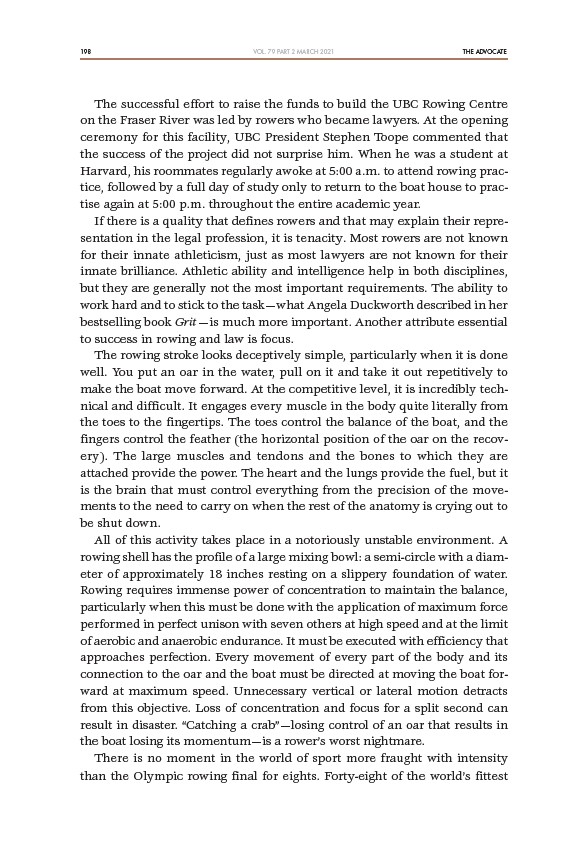
198 THE ADVOCATE
VOL. 79 PART 2 MARCH 2021
The successful effort to raise the funds to build the UBC Rowing Centre
on the Fraser River was led by rowers who became lawyers. At the opening
ceremony for this facility, UBC President Stephen Toope commented that
the success of the project did not surprise him. When he was a student at
Harvard, his roommates regularly awoke at 5:00 a.m. to attend rowing practice,
followed by a full day of study only to return to the boat house to practise
again at 5:00 p.m. throughout the entire academic year.
If there is a quality that defines rowers and that may explain their representation
in the legal profession, it is tenacity. Most rowers are not known
for their innate athleticism, just as most lawyers are not known for their
innate brilliance. Athletic ability and intelligence help in both disciplines,
but they are generally not the most important requirements. The ability to
work hard and to stick to the task—what Angela Duckworth described in her
bestselling book Grit —is much more important. Another attribute essential
to success in rowing and law is focus.
The rowing stroke looks deceptively simple, particularly when it is done
well. You put an oar in the water, pull on it and take it out repetitively to
make the boat move forward. At the competitive level, it is incredibly technical
and difficult. It engages every muscle in the body quite literally from
the toes to the fingertips. The toes control the balance of the boat, and the
fingers control the feather (the horizontal position of the oar on the recovery).
The large muscles and tendons and the bones to which they are
attached provide the power. The heart and the lungs provide the fuel, but it
is the brain that must control everything from the precision of the movements
to the need to carry on when the rest of the anatomy is crying out to
be shut down.
All of this activity takes place in a notoriously unstable environment. A
rowing shell has the profile of a large mixing bowl: a semi-circle with a diameter
of approximately 18 inches resting on a slippery foundation of water.
Rowing requires immense power of concentration to maintain the balance,
particularly when this must be done with the application of maximum force
performed in perfect unison with seven others at high speed and at the limit
of aerobic and anaerobic endurance. It must be executed with efficiency that
approaches perfection. Every movement of every part of the body and its
connection to the oar and the boat must be directed at moving the boat forward
at maximum speed. Unnecessary vertical or lateral motion detracts
from this objective. Loss of concentration and focus for a split second can
result in disaster. “Catching a crab”—losing control of an oar that results in
the boat losing its momentum—is a rower’s worst nightmare.
There is no moment in the world of sport more fraught with intensity
than the Olympic rowing final for eights. Forty-eight of the world’s fittest